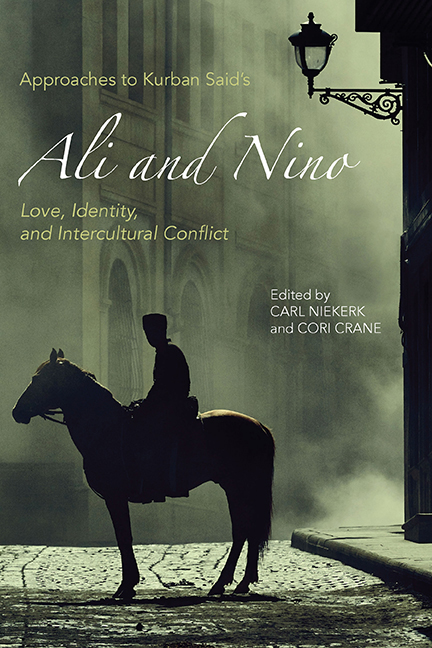Book contents
- Frontmatter
- Contents
- Acknowledgments
- Notes on Editions of and References to Ali and Nino
- Introduction: Ali and Nino as World Literature
- 1 Ali and Nino: The Novel as/of Cultural Translation
- 2 Crossing Borders, Crossing Disciplines: Ali and Nino in the Twenty-First Century
- 3 Glowing Rubies and Persian Daggers: The Role of Persian Poetry in Ali and Nino
- 4 Gendered Stereotypes and Cross-Cultural Moral Values through the Eyes of Kurban Said
- 5 Orientalist Itineraries: Cultural Hegemony, Gender, Race, and Religion in Ali and Nino
- 6 Gendered Conflicts in Muslim and Christian Cultures: Honor (and Shame) in Ali and Nino
- 7 Love and Politics: Retelling History in Ali and Nino and Artush and Zaur
- 8 “Herr Professor, Please: We'd Rather Stay in Asia”: Ali Khan Shirvanshir and the Spaces of Baku
- 9 The Female Body and the Seduction of Modernity in Ali and Nino
- 10 Seeing the Unseen: Symbolic Writing in Ali and Nino
- 11 Ali and Nino and Jewish Questions
- 12 Between Orientalism and Occidentalism: Culture, Identity, and the “Clash of Civilizations” in Ali and Nino
- Works Cited
- Notes on the Contributors
- Index
3 - Glowing Rubies and Persian Daggers: The Role of Persian Poetry in Ali and Nino
Published online by Cambridge University Press: 30 August 2017
- Frontmatter
- Contents
- Acknowledgments
- Notes on Editions of and References to Ali and Nino
- Introduction: Ali and Nino as World Literature
- 1 Ali and Nino: The Novel as/of Cultural Translation
- 2 Crossing Borders, Crossing Disciplines: Ali and Nino in the Twenty-First Century
- 3 Glowing Rubies and Persian Daggers: The Role of Persian Poetry in Ali and Nino
- 4 Gendered Stereotypes and Cross-Cultural Moral Values through the Eyes of Kurban Said
- 5 Orientalist Itineraries: Cultural Hegemony, Gender, Race, and Religion in Ali and Nino
- 6 Gendered Conflicts in Muslim and Christian Cultures: Honor (and Shame) in Ali and Nino
- 7 Love and Politics: Retelling History in Ali and Nino and Artush and Zaur
- 8 “Herr Professor, Please: We'd Rather Stay in Asia”: Ali Khan Shirvanshir and the Spaces of Baku
- 9 The Female Body and the Seduction of Modernity in Ali and Nino
- 10 Seeing the Unseen: Symbolic Writing in Ali and Nino
- 11 Ali and Nino and Jewish Questions
- 12 Between Orientalism and Occidentalism: Culture, Identity, and the “Clash of Civilizations” in Ali and Nino
- Works Cited
- Notes on the Contributors
- Index
Summary
“CLOSE YOUR EYES, cover your ears with your hands and open your soul” (82; Rasch die Augen schließen, mit den Händen die Ohren zuhalten und in sich versinken, 82). With this enigmatic observation, Ali Khan Shirvanshir, the main Muslim figure in Kurban Said's novel Ali and Nino, advises his Western readers about the art of viewing Persian opera. He continues, “The spectators tremble and weep. A Mullah passes along the rows collecting tears with cotton wool. There are strong magical powers in these tears. The deeper the beholder's faith, the greater is the effect of the play on him” (82; Die Zuschauer zittern und weinen. Ein Mullah geht durch die Reihen und sammelt mit Watte die Tränen der Zuschauer in eine kleine Flasche. Magische Kräfte aller Art sind in diesen Tränen enthalten. Je tiefer der Glaube der Zuschauer, desto gewaltiger die Wirkung des Spieles, 83). The deep connection between Persian faith and artistic or poetic performance is here emphasized, as is the implicit cultural foreignness of this experience for the European reader. Said tells us, art lives within the Persian soul. In contrast Ali describes in the same passage the Western audience's experience at the opera as sterile and distant: “Now open your eyes, drop your hands and look around” (83; Nun die Augen öffnen, die Hände sinken lassen und sich umschauen, 83). Filled with electric lights, plaster-of-Paris statuary, naked female arms and backs, bald-headed gentlemen, and a dark abyss, the Western opera house separates the viewer from the performers with a faceless orchestra playing in the darkness. Said's novel draws on many such comparative and confrontational cultural moments via poetry and poetic performance in an obvious effort to provoke the reader's introspection and to promote cultural tolerance and acceptance. Why does Said choose to use poetry and poetic performance as a programmatic metaphorical tool throughout his novel? And what is the ultimate aim of placing poetry and performance in such a central role?
Poetry and verse shimmer beneath the surface of Said's narrative, peeking through in brief flashes to enhance it and at other times fully surfacing to become the story itself.
- Type
- Chapter
- Information
- Approaches to Kurban Said's Ali and NinoLove, Identity, and Intercultural Conflict, pp. 50 - 72Publisher: Boydell & BrewerPrint publication year: 2017

